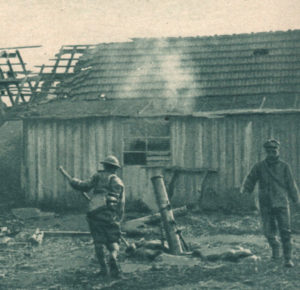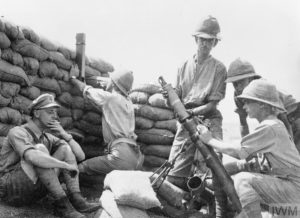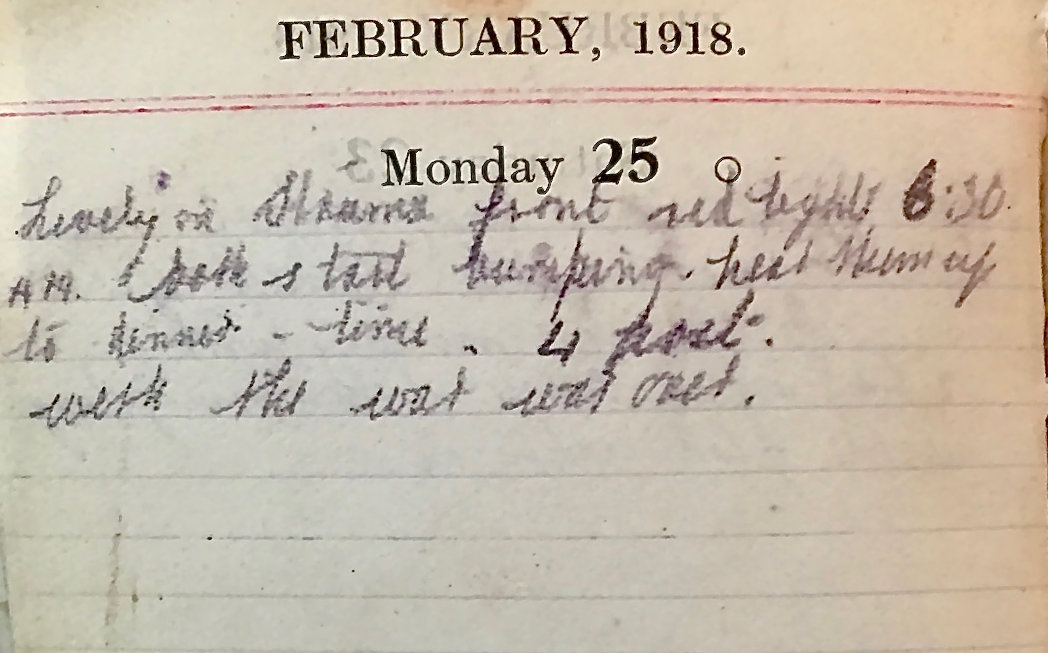Monday Feb 25th, 1918
Lively on Struma Front – red lights 6:30am both start bumping. Heat keeps up to dinner time. Four post. Wish the war was over.
In ‘The Times’
Today Frank witnessed some red flares being fired as a signal for the enemy attack on Struma. Of the 90 miles of the British front, that which runs along the Struma valley is the most easterly. The line continues westward with the Krusha Balkan Hills, the Dojran front and the Vardar sector. The enemy also shelled a variety of locations closer to home including the Dojran Road camp, location of D Company.
On Wednesday Feb 27th, 1918 – The Times will report, ‘A communique issued in Paris yesterday stated that on Monday there were, in the Balkan theatre, artillery actions on the Dorian front and to the west of the Vardar.’
Trench Mortars
Trench Mortars feature heavily in the entries of the Battalion’s diary and were used extensively during WWI on all fronts. The weapon type had been around for over a century but, by the outbreak of war, had been out of favour in Britain for 50 years. However the static warfare of the trenches and the Germans’ success with their Minenwerfer mortars, revived interest in the weapon.
Trench Mortars were indirect fire weapon whose shells could be lobbed into the air. As such they could be used against enemy trenches, gun emplacements and even barbed wire. Their usefulness meant that the French and British were forced to dust off some Napoleonic era examples and send them to the Western Front. However, over the course of the war, a variety of classes of trench mortars were introduced by the Allies for use by both the Royal Artillery and the Infantry.
6″ Newton Mortars

The Royal Artillery were responsible for the larger, less mobile trench mortars. For the British Salonica Force (BSF), this included the 6 inch Newton Mortars deployed by the Medium Trench Mortar Batteries from early 1917.
When disassembled they could be carried on a cart to another site so had some mobility. Indeed the Canadians had some success using them mounted on trucks when the war again became mobile in France during 1918. That said, the shells alone weighed 52 lbs.
Their standard range was about 1000 yards but could be increased or decreased by adding or removing cordite propelling charge bags. The minimum range was 100 yards (because of blast radius) and the maximum 1400 yards.
Stokes Mortars

Each Infantry Brigade in the BSF also had dedicated light artillery units. For example, the 66th Brigade (to which the 13th Manchester belonged) had a Machine Gun Company, an SAA¹ Section Ammunition Column and a Trench Mortar Battery. The latter would have used Stokes Mortars.
This photograph shows a Stokes Mortar in action in a trench on the Balkan front. The shell is about to be dropped down the tube, where a firing pin will detonate the propellant and launch the shell. Notice the tropical uniforms and helmets worn by the soldiers.
These were invented in 1914 by Wilfred Stokes, the Managing Director of a mechanical engineering company in Ipswich. They weighed only 108 lbs and could be broken into three smaller units for carrying. The shells weighed 11 lbs each. While not as powerful as the Newton Mortars, their range was similar, a minimum of 100 yards, average 800 and, if deploying extra rings of propellant, a further 400 yards. Their elevation ranged from 45 to 75 degrees and targets were lined up using a painted white line on the tube. They could fire about 25 shells a minute and required only a two man crew. This simple yet effective weapon would earn Stokes a knighthood after the war.
13th (Service) Battalion War Diary – 25th February 1918 – No 1 Sector, Minden Camp
Our artillery was only moderately active. Enemy artillery was mostly inactive until the afternoon when he shelled the sector generally. He fired about 20 heavy high explosives into Deep Cut Ravine and about 30 high explosives and shrapnel on the west slope of Basing Hill. Our trench mortars fired 3 rounds into O2. Enemy put 10 in Dojran Road Camp. There was the usual combined artillery and machine gun scheme on enemy working parties in O2. At 11:55 hrs an enemy plane was seen returning beyond its own lines. The usual patrols went out but had nothing to report. Enemy is still busy working on the places previously mentioned.
References & Further Reading
¹ Small Arms Ammunition
* photograph of Canadians firing 6″ Newton Mortar. “The Great War Volume XII” edited by H W Wilson, published 1919. (British Government) Page 290. Public Domain
# Stokes Mortar in the Balkans, Imperial War Museum
‘Stokes Mortar (3 inch) 81mm Trench Mortar‘, Military Factory
‘The 3 inch Stokes Mortar‘ at worldwar1.com


